Adhesives bind key mattress components together, and the segment is changing quickly to meet manufacturers’ needs for faster drying times, firm sets and environmentally friendly materials
The whole point of using adhesives is to make different surfaces stick together — and stay put — for a long time. And yet bedding adhesives is not a product segment that is set in stone.
In today’s fast-moving sleep products marketplace — where the move toward boxed bed constructions and online selling has caused major disruptions for manufacturers and retailers alike — adhesive suppliers also have entered a dynamic period of change as they respond to new needs and emerging opportunities. For starters, they are developing water-based and hot-melt adhesives that respond to mattress manufacturers’ demands for high-quality, more environmentally friendly glues that dry quickly and hold firmly. At the same time, they are looking for ways to help bed producers cut costs and improve efficiencies, either by reducing the amount of adhesive required for bonding mattress layers, the time involved in application and drying, or both.
In addition, a number of adhesive suppliers are seeing a new opportunity beyond their core segment — in the cooling arena — and are developing technologies that leverage their strengths in formulations, applications and coatings.
 Addressing the “pain point”
Addressing the “pain point”
“With the increase in boxed bed offerings, drying of roll-coat-applied, water-based adhesives has become more of a challenge due to the fast line speeds of producing the mattress laminations,” says Steven Adams, business manager for Worthen Industries’ Upaco Foam Fabricating Adhesives Group in Richmond, Virginia. “The laminations need to be sufficiently dried before compressing, folding, rolling and packaging.”
Due to the ever-increasing speeds involved in manufacturing laminated mattresses, the “pain point of removing the moisture from the adhesive has become more severe,” Adams says. “(Our new) drying method addresses this pain point and eliminates it as an issue.”
In 2018, Upaco was awarded a patent on a novel method that allows the mattress to dry within minutes after lamination. This new method is an advancement from current drying methods, which use heat to partially dry the adhesive after it is applied to the foam, but before the layers are put together, Adams says.
“This can create problems with adhesion as the adhesive can be dried too much before assembly, causing poor bonds,” Adams says. “On the other hand, if you do not dry the adhesive enough before the layers are put together, then there is no real benefit of using the current drying method, and the lamination may still need to sit for several hours before packaging.”
According to Adams, Upaco’s patented drying method not only removes all of the water from the mattress, but also allows the company more latitude in formulating its adhesives.
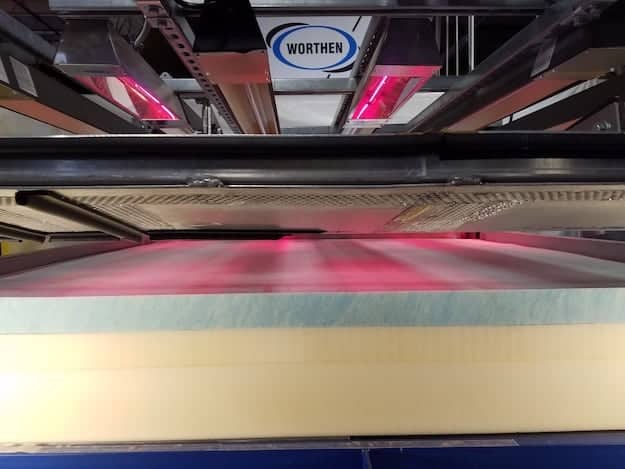
This drying device, available from Worthen Industries’ Upaco Foam Fabricating Adhesives Group, is used to accelerate the drying of water-based adhesives used in foam assembly.
“This expanded latitude in formulation provides other improvements, such as laminating adhesives that are cleaner to run on roll coaters, which reduces down time and application rate inconsistencies due to dirty application rolls; adhesives that allow for lower application rates that save money; and adhesives that are easier to clean at the end of production shifts, providing a savings in labor,” Adams says.
Upaco develops, manufactures and markets water-based and hot-melt adhesives for the bonding of all types of foams, nonwovens, quilted pillow-tops and other standard cushioning materials used in mattress and furniture cushion fabrication. The company also manufactures some specialty adhesives, such as extruded film adhesives and moisture-curing products that bond foams together.
“We are in the unique position of manufacturing more than one chemical base, which allows us to fully understand and represent accurately and honestly the pros and cons of each type of adhesive,” Adams says.
Upaco’s latest offering to mattress manufacturers is its SprayClean formulations and spray device, a technology that sprays adhesive components using no atomization air. This approach eliminates overspray fog, creating a cleaner work environment for employees, reducing maintenance on nearby equipment, such as tape-edger machines and quilters, and decreasing possible contamination of finished inventory stored close to the spray area, according to the company.
The high transfer efficiency of the SprayClean spray system also saves money due to lower material usage, Adams says.
Reducing overspray
At this year’s Interzum Cologne in Cologne, Germany, Simalfa debuted a number of water-based adhesives for the sleep products industry. Introductions included additions to its line of zero-dry-time, roll-applied, infrared heat-dried adhesives for instant roll packing. IR adhesives are designed for use with infrared drying machines. Simalfa also offers non-IR adhesives that dry quickly without the need of special equipment.
In addition, the company expanded its Overspray Free product line with polyurethane-based one-part and two-part options. The two-part adhesives, which utilize a second component to increase initial tack, manage to do so without solvents. Designed primarily for the bedding industry, Simalfa’s Overspray Free line creates a weblike spray pattern that prevents adhesive particles from going airborne and creating a “cloud,” ensuring a clean, safe and waste-free environment, according to the company.
“We’re using chemistry to control overspray, which is a very cutting-edge approach,” says Harry Bajakian, national sales manager for Simalfa. “Using equipment to accomplish this has always been impossible as settings can easily be changed by the operator, throwing everything off. Manipulating the chemistry removes operator input and enables us to eliminate overspray and keep the result consistent.”
Simalfa, which is based in Hawthorne, New Jersey, offers more than 150 adhesive formulations, providing a “broad range of options for the mattress industry,” Bajakian says. The company’s offerings include adhesives for use with latex, polyurethane foams, viscoelastic foams, fabrics and fibers.
“We’re an environmental company so our focus is purely water-based technology,” he says. “With so many products to choose from, we can easily meet the goals of any client, whether it be super-fast-drying IR and non-IR products for roll coating or Overspray Free technology applied via manual and automatic spray.”
As roll-packed foam mattresses become a larger part of the industry, producers are looking for cost-effective ways to consistently produce a quality mattress that can be roll packed immediately, according to Bajakian. “We have responded by working directly with our customers to implement specific products and processes on their existing machinery to allow for maximum speed and output,” he says. “Our wide array of formulations has made it easy for us to accommodate each unique situation.”
Simalfa’s experience in adhesives led to the development of the company’s new KulKote Temperature Regulating Technology. “As gel products have fallen out of favor, the bedding industry has been looking for the next innovation in cooling. Phase-change material is the answer, but the challenge is PCMs have always been very difficult to bond to foams and fabrics. Our expertise in adhesives helped us to develop products that outperform traditional PCM technology.”
To keep up with the growth of Simalfa and KulKote technologies, Simalfa recently hired three new production employees. In addition, the company expanded its sales team with the hiring of Rene Montano. Responsible for the company’s southeastern region, Montano has been in the bedding industry for a number of years on the adhesive automation side. “His experience perfectly complements the trends we’re seeing in the industry with roll-packed mattresses,” Bajakian says.
Simalfa also has added Robinson Miranda to its team to handle inside sales for the United States and South America. Like Montano, Miranda is fluent in Spanish and has helped Simalfa “better communicate with our Spanish-speaking customers in North and South America,” Bajakian says.
New CR-free alternative
At SABA, the big news at Interzum Cologne was the launch of its new CR-free line of adhesives. CR, or chloroprene rubber, is an elastomer used as a binder for water-based adhesives that is popular because of its ability to combine strong bonding properties with a high-quality result.
But while demand for CR across a wide range of industries is growing worldwide, production of this material is not keeping pace. The market imbalance is leading to supply shortages and rising prices for CR. This instability could eventually impact the ability of some adhesive producers to supply their customers with affordable water-based CR adhesives, according to Jim Turner, president of Kimball, Michigan-based SABA North America and global sales manager of SABA, headquartered in Dinxperlo, Netherlands. The company offers a full line of water-borne and hot-melt adhesives.
To get ahead of possible shortages, SABA started searching for alternatives to CR a few years ago, Turner says. The result is a new generation of CR-free adhesives with properties similar to SABA’s CR-based adhesives. In addition, SABA’s CR-free line is free of any chlorine, which makes it more environmentally friendly than traditional adhesives.
“These new products perform extremely well in both spray and roller applications,” Turner says, adding that the line allows SABA to “provide our customers with a stable supply chain in a volatile market.”
SABA’s CR-free adhesives can be incorporated easily into existing production processes, Turner says. It is only a matter of flushing the existing SABA adhesive lines and cleaning spray equipment.
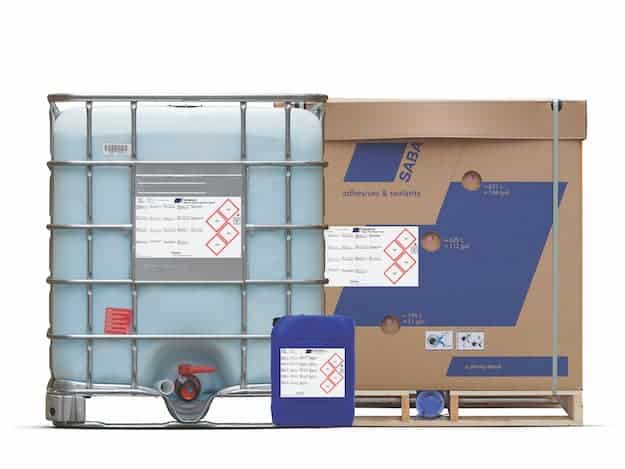
SABA’s Sababond water-based adhesives have a very short drying time, allowing mattresses to be roll packed immediately after assembly. The surge in boxed-bed sales has put new demands on bonding processes.
To help customers keep pace with another major market change — the surge in boxed-bed sales — SABA offers Sababond 3676, a thermal-activated, rollable adhesive. Designed for “produce and pack” manufacturers that incorporate drying units into their production lines, Sababond 3676 allows mattresses to be roll packed immediately after assembly. The approach speeds up the packaging process and reduces the need for both additional warehouse space and double handling of mattresses.
“Sababond 3676 also is easier to apply and is less prone to thickening on the rollers throughout the production day, providing a more consistent application rate and a more efficient foam bonding process,” Turner says.
The rise in demand for boxed beds is proving to be an industry “game changer,” Turner says. “It has put new demands on adhesives and bonding processes since drying time is such a critical issue,” he says. “If you’re banging out 1,000 mattresses a day, you can’t afford to wait for your traditional water-based adhesive to sit and dry before packing.”
SABA had a head start on addressing this challenge because some of its customers were roll packing mattresses as long as a decade ago, Turner says. “We’ve been working on our formulations for this segment for many years and are always looking for ways to reduce the moisture content during application and the recovery time after the mattress is unpacked,” he says.
Another area that has gotten a lot of attention from SABA is overspray. A few years ago, the company introduced a zero-overspray spray gun technology to eliminate waste. A number of SABA’s customers have converted to the system, a change that has resulted in cost savings on materials, as well as cleaner work environments, Turner says.
In addition, SABA entered a new product category at Interzum Cologne in May with the debut of its Sabacool cooling technology. The system leverages the same drying technology used for its “produce and pack” adhesive line to offer manufacturers a PCM solution that can be roll coated on a top layer of foam and instantly dried.
In other news, SABA launched a new website in July. The site includes a knowledge center where customers can download product information, safety sheets and other materials specific to their operations, says Chris Belterman, a marketing and communication specialist with SABA.
A complete suite of solutions
Henkel Corp., based in Düsseldorf, Germany, with U.S. offices in Rocky Hill, Connecticut, and Bridgewater, New Jersey, offers a complete portfolio of adhesive solutions for mattress construction. Technologies include the Technomelt line of thermoplastic hot melts, Technomelt PUR reactive hot melts, Aquence water-borne and Loctite solvent-borne contact adhesives, and Aquence acrylic polymers.
“Depending on the user’s desire and end product requirements, there are advantages across the technology spectrum” for both hot-melt and water-borne adhesives, says Tim Brown, director of market development, technical service for furniture and building components at Henkel. “Hot-melt products are 100% solids, which removes any moisture from the process, imparting high-heat-resistant bonds and application versatility. Water-borne products allow for repositionable assembly and ambient temperature application options. Our reactive hot melts offer significant bond performance with a high level of flexibility.”

Henkel Corp.’s North American leadership team for adhesive technologies celebrates the opening of the company’s new OEM Application Center in Rocky Hill, Connecticut.
Going forward, Henkel plans to continue adding to the Technomelt polyolefin technology platform to meet the myriad requirements of the mattress marketplace globally. “Continuous introduction of newer substrates, construction processes and end user preferences can be achieved within this technology group,” Brown says.
When bringing new products to the market, Henkel works closely with mattress producers to optimize application methods and equipment design. Several new application options and technology advancements are under evaluation as “horizon requirements” for the next generation of mattresses, Brown says.
“Given the global breadth and product development platforms available within Henkel, (recent) collaborations have guided us toward smart technologies that can provide a host of end user solutions,” he says. “Suffice it to say, we are working on adhesive solutions that also ‘think,’ ‘communicate’ and ‘indi-cate.’ ”
To help mattress producers stay competitive, Henkel is working on a number of other hot-button issues, such as “substrate evolution, speed of process, light-weighting of goods and noise-free constructions,” Brown says. “At Henkel, we have embraced these and other one-off challenges with continued development of innovative adhesive products that serve emerging needs.”
One of the intriguing elements of the adhesive sector is that new opportunities can arise suddenly, as well as from ongoing research conducted over longer periods of time, Brown says. During the past 15 years, the life cycles of sleep product design and manufacturing processes have shortened, “creating more frequent opportunities” for new materials and methods, he says.
By offering a full complement of adhesive technologies, Henkel enables manufacturers to stay flexible as market needs shift. “Low-temperature hot melts, thinner fabrics, lower application rates and lighter weight materials all hold opportunity for future refinements,” he says.
To stay ahead of fast-changing developments in the company’s industrial assembly sector, of which sleep products are a part, Henkel opened a new OEM Application Center at its U.S. headquarters in Rocky Hill last spring. The facility is the third lab for Henkel, which has similar facilities in Asia and Western Europe. The lab expands Henkel’s capabilities to deliver innovative solutions and design customized applications, technologies and production processes to better serve customers’ needs, according to the company.
The lab also incorporates audiovisual and interactive telepresence systems, which enable more rapid collaboration and virtual demonstrations with OEM customers, distributors and process operators. This helps to further bolster productivity and increase awareness and knowledge of new adhesive applications, according to the company.
Precision is a top priority
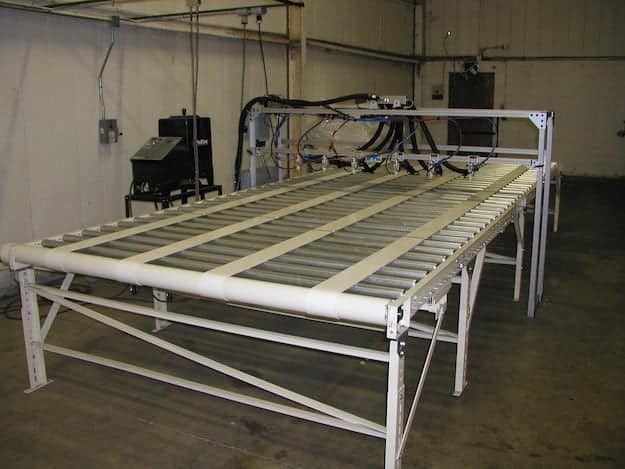
Hot Melt Technologies offers mattress producers a full range of equipment for both automated and hand-held (below, left) applications of hot-melt adhesives.

Hot Melt Technologies offers a full range of hot-melt adhesive application systems to meet the requirements of both traditional mattress manufacturers and boxed-bed producers of any size, Jones says. The company’s line includes hot-melt systems for foam-encased, pillow-top and pocket coil assemblies, as well as foam layer laminations. All of the systems are based on the company’s innovative ProFlex design concept, with modular components that fit precise applications and process requirements.
“Boxed bed sales are growing quickly,” Jones says. “And as manufacturers increase production, the speed offered by hot-melt adhesives will become even more important in their assembly process. We are ready for them.”
Designed for production flexibility, all of the company’s equipment can be used with either handguns or automated systems, and in bead or spray patterns, Jones says. The company also offers solvent-free hot-melt adhesives for every type of application.
Recently, Hot Melt Technologies introduced its DG-501 In-Line Spray Handgun, which increases operator comfort and productivity, and offers easy in-plant serviceability, Jones says. “Another innovation is our patent-pending Load Alert that informs the operator when to load more adhesive into the melt tank,” he says.
Hot Melt Technologies continually is upgrading its website with application and how-to videos. The site also offers direct access to the company’s tech support department. “HMT is 100% focused on providing all the services and support necessary to keep mattress assembly plants up and running with no downtime,” Jones says.
Innovative hot melts
As the pace of mattress production has increased in recent years, the demand for faster gluing processes that allow manufacturers to assemble the mattress and then immediately pack and ship it also has grown, says Paolo Campitelli, account manager for Savare Specialty Adhesives’ U.S. office in Delaware, Ohio. “At the same time, new, challenging substrates, such as microcoils and gel-infused foams, are becoming more and more common, and the number of different material combinations has added complexity to the system.”
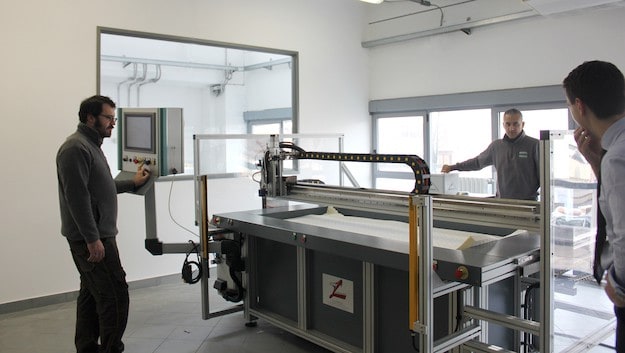
Marco Covini (right), industry manager for Savare Specialty Adhesives, watches as two technicians program a robotic adhesive applicator in the company’s lab.
In response, Savare has developed hot-melt adhesives that combine a high level of bonding performance with process flexibility and no residual noise, “allowing our customers to improve their manufacturing process and bring a superior and consistent product into the market,” Campitelli says.
Milan, Italy-based Savare, which entered the U.S. market five years ago, specializes in 100% solvent-free and water-free hot-melt adhesives that are environmentally friendly and mold-proof. For the mattress market, it offers a wide range of products suitable for all types of substrates and processes. According to Savare, a low-volume, single-side application provides a nearly immediate, strong bond with no need for drying or curing.
“The result is a very efficient, clean and fast process,” says Marco Covini, industry manager for Savare. “The mattress can be moved, packed and shipped immediately after production, and this is becoming more important every day.”
In addition, “while residual noise on convoluted substrates has always been considered the traditional weakness for hot melts, our more recent developments have completely overcome this limitation,” Covini adds.
To keep pace with the fast-changing sleep products market, Savare “never stops innovating,” Covini says. “We work in tight connection with our customers and co-suppliers anticipating market challenges, such as new substrates or process changes, and providing effective, user-friendly adhesive solutions,” he says.
Besides the noiseless options, Savare has introduced hot melts with uncompromised bonding performance to the most difficult substrates, specific adhesives for high-speed automatic processes, and high-yield products to offset the fluctuations that can occur in more manual operations.
Savare’s manufacturing expertise, acquired through its longtime involvement in the highly mechanized Italian and European mattress markets, has been an asset for U.S. producers as they switch from labor-intense manual processes to a more automated approach, Campitelli says.
“Savare embraces challenges. They provide us the opportunity to find a better solution for our customers and become a more valuable partner,” Campitelli says. “We have an R&D team and a state-of-the-art facility fully dedicated to the mattress market. We can build a mattress, perform numerous tests and compare adhesive performance/characteristics all in-house.”
Founded in 1924, Savare continues to be a family-owned enterprise. Recently, Pietro Savare, a fourth-generation member of the founding family, joined the company as a chemical engineer. In this role, he leads the company’s process efficiency and digitalization efforts.
In recent months, the company has updated its marketing and communication strategy, rolling out a new website and fresh logo, as well as a new advertising campaign. In February, Procter & Gamble honored Savare with a Supplier Excellence Award. The prize was awarded to 36 of P&G’s top external business partners for their sustained business contributions. P&G has more than 50,000 suppliers worldwide.
The need for speed
Jowat Corp. offers water-based and hot-melt adhesives, providing a range of solutions to meet the requirements of its customers’ preferred production processes. Both water-based and hot-melt products offer environmental advantages over older, solvent-based technologies, according to John Elder, national sales manager of the Archdale, North Carolina-based company.
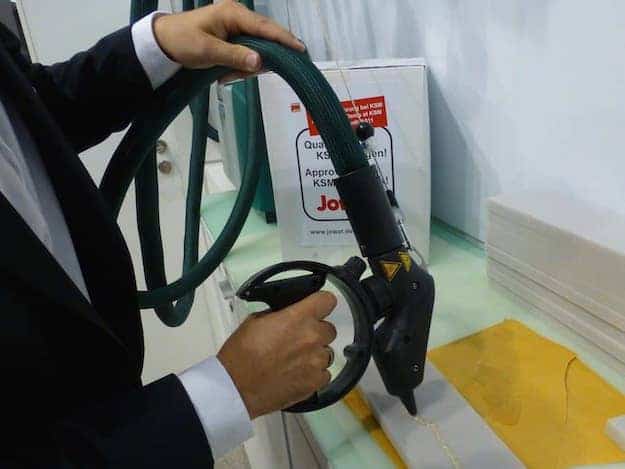
Jowat Corp. offers a broad range of hot-melt (pictured) and water-based adhesives.
“They allow you to eliminate the solvent emissions and also eliminate the carcinogenic or flammable hazards that come with many solvent-based products,” Elder says. Hot melt, he says, offers one more advantage in that it can be applied at increased manufacturing speeds without the need for extensive ventilation or drying equipment.
Jowat’s latest innovations target the growth in specialty mattress foams. “We have broadened the adhesion range of our core products to improve adhesion to viscoelastic and gel foam mattresses,” Elder says. “In the past, we had specific formulas for viscoelastic foam. However, custom mattress manufacturers can use a variety of foams during a production day, so we’ve upgraded our adhesives to work with all of the latest types of foam. One hot-melt adhesive can now do it all.”
Speed, foam composition and noise reduction are key areas of focus in Jowat’s product development efforts. “Water-based adhesives need time to dry to achieve strength, as well as eliminate the risk of mold,” Elder says. “Solvent-based products also limit assembly speed since they need time for solvent to evaporate to reduce odor or flammability.”
In Elder’s opinion, hot-melt adhesives don’t have these drawbacks and, thus, represent “the best option for high-speed production.”
Foam composition also poses a challenge as manufacturers continue to innovate and improve foam properties. To keep up, Jowat is “continuously testing and adjusting adhesive formulas,” Elder says. In the past, noise has been a challenge for hot-melt adhesives, according to Elder, “as older formulas tended to have residual surface tack and produce a ‘Velcrolike’ sound in a finished mattress. Our newest hot-melt adhesive formulas have eliminated mattress adhesive noise.”
As hot-melt adhesive usage grows within mattress assembly, environmental impact becomes a larger consideration for manufacturers, according to Elder. “For years, Jowat has been a leader in incorporating new, renewable resource raw material ingredients into our formulations,” he says. “Our adhesives are no longer just a bonding solution but are also an environmental sustainability solution.”
This year is special for Jowat, as it is celebrating its 100th anniversary as an adhesive manufacturer. “Adhesive technology has changed dramatically over the past 100 years,” he says, “and mattress assembly technology is no different.”





